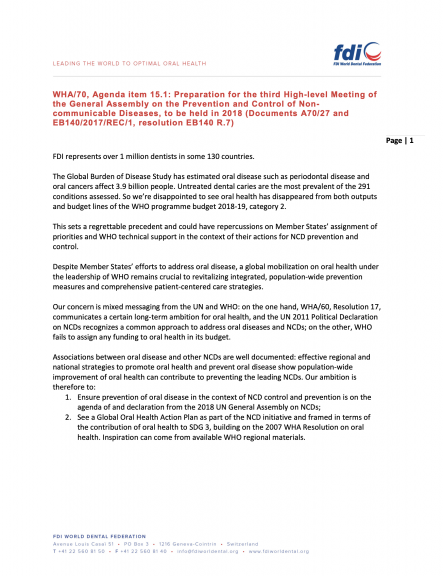
WHA70 - Preparation for the third High-level Meeting of the General Assembly on the Prevention and Control of Noncommunicable Diseases
Agenda item 15.1 (Documents A70/27 and EB140/2017/REC/1, resolution EB140 R.7)
FDI represents over one million dentists in some 130 countries.
The Global Burden of Disease Study has estimated oral disease such as periodontal disease and oral cancers affect 3.9 billion people. Untreated dental caries are the most prevalent of the 291 conditions assessed. So we’re disappointed to see oral health has disappeared from both outputs and budget lines of the WHO programme budget 2018-19, category 2.
This sets a regrettable precedent and could have repercussions on Member States’ assignment of priorities and WHO technical support in the context of their actions for noncommunicable disease (NCD) prevention and control.
Despite Member States’ efforts to address oral disease, a global mobilization on oral health under the leadership of WHO remains crucial to revitalizing integrated, population-wide prevention measures and comprehensive patient-centered care strategies.
Our concern is mixed messaging from the UN and WHO: on the one hand, WHA/60, Resolution 17, communicates a certain long-term ambition for oral health, and the UN 2011 Political Declaration on NCDs recognizes a common approach to address oral diseases and NCDs; on the other, WHO fails to assign any funding to oral health in its budget.
Associations between oral disease and other NCDs are well documented: effective regional and national strategies to promote oral health and prevent oral disease show population-wide improvement of oral health can contribute to preventing the leading NCDs. Our ambition is therefore to:
- Ensure prevention of oral disease in the context of NCD control and prevention is on the agenda of and declaration from the 2018 UN General Assembly on NCDs;
- See a Global Oral Health Action Plan as part of the NCD initiative and framed in terms of the contribution of oral health to SDG 3, building on the 2007 WHA Resolution on oral health. Inspiration can come from available WHO regional materials.
